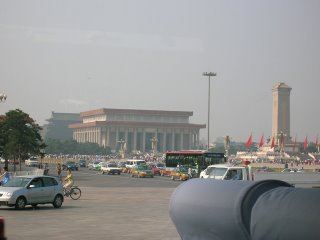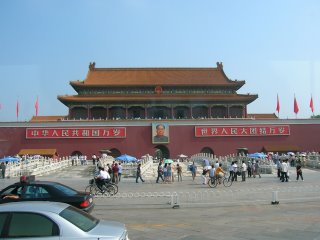First order of business upon return was the Great Wall - because if you come to China and don't go, they make fun of you and take away your passport ("No more travel for you, you cretin! If you can't be trusted to travel responsibly...").
The Great Wall is called Changcheng in Chinese, and they started working on one section of the original wall around 2000 years ago during the Qin dynasty (same guy with the Terra Cotta warriors). One of the legends is that in addition to dirt and stone, the bones of the workers (peasants and political prisoners) are in the core of the wall.
The section we visited is at Badaling, and it was built during the Ming dynasty, and then restored in the 1950s and again in the 1980s. When you climb upon the wall you can turn either left or right. Right will take you on a more leisurely stroll, and left is the more difficult climb. Everyone turned left, of course. As far as I can tell, a big chunk of this portion of the wall is basically up. Like at a good 40 degree angle. No, I wasn't there with my protractor and compass, but let's just say it was a steep angle, shall we? There's a railing, but it was obviously designed with someone much shorter than I am in mind, as I spent a lot of time bent nearly double. And before you say anything, I'd like to point out that many of the Chinese people on the wall were hunched over, too.
Where the wall wasn't sloping upward were sets of stairs, many of which seemed to go straight upward at a 90 degree angle. And if that's not enough fun, the steps were uneven, some a few inches high and some as high as my knee. I did not travel all the way to the end of the restored portion, but I did pass three watchtowers, which I felt was a respectable distance. It was a rainy day, so it was cool (yay!) and misty, which made for lowered visibility, especially the higher you climbed. So, here are some pictures, but the caveat is that I did the best under the circumstances. And also it's very difficult to convey the depth of stairs, so you don't really get a sense of the view downward or of the death defying and exhilarating experience I found it to be. I am also no longer afraid of the elliptical machine at my gym - it doesn't begin to get close to the wall.


I will also add this: there's a Starbucks at the wall. Does anyone doubt the strength of capitalism? And if that's not enough, then there are all the vendors on the wall selling "I climbed the wall t-shirts. Yes, I bought one. Silly question.
In the afternoon we visited one of the Ming tombs - apparently 13 of the 16 Ming emperors are buried in these sites. They are based on a Confucian layout, and only three are open to the public. Only one has been fully excavated, and that's the one we didn't go to. The one we visited is Chang Ling, and is the burial place of emperor Yongle. It's in a pretty spot, but otherwise it wasn't very exciting - the emperor is under a burial mound at the bank, and it's covered with trees and grass. There was a museum with some really pretty artifacts, which you can see in these pictures here.



























